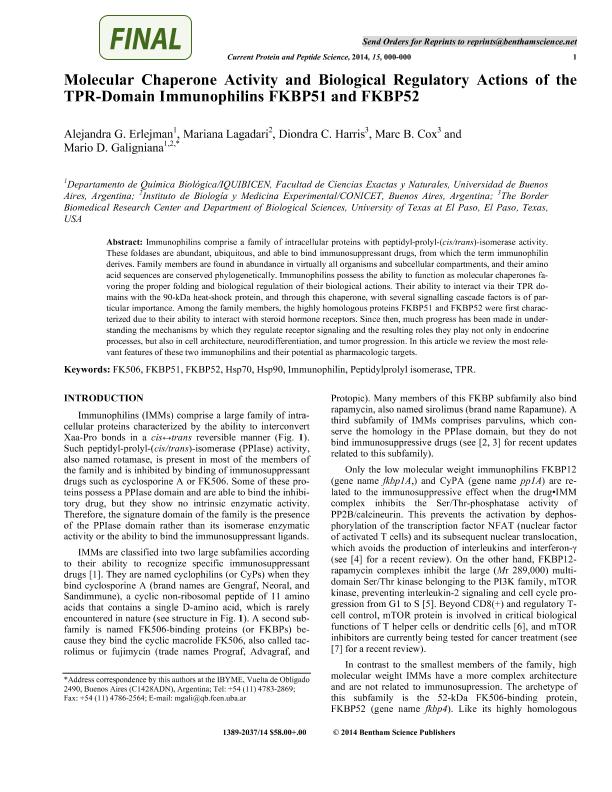Artículo
Molecular chaperone activity and biological regulatory actions of the TPR-domain immunophilins FKBP51 and FKBP52
Erlejman, Alejandra Giselle ; Lagadari, Mariana
; Lagadari, Mariana ; Harris, Diondra C.; Cox, Marc B.; Galigniana, Mario Daniel
; Harris, Diondra C.; Cox, Marc B.; Galigniana, Mario Daniel
 ; Lagadari, Mariana
; Lagadari, Mariana ; Harris, Diondra C.; Cox, Marc B.; Galigniana, Mario Daniel
; Harris, Diondra C.; Cox, Marc B.; Galigniana, Mario Daniel
Fecha de publicación:
05/2014
Editorial:
Bentham Science Publishers
Revista:
Current Protein and Peptide Science
ISSN:
1389-2037
e-ISSN:
1875-5550
Idioma:
Inglés
Tipo de recurso:
Artículo publicado
Clasificación temática:
Resumen
Immunophilins comprise a family of intracellular proteins with peptidyl-prolyl-(cis/trans)-isomerase activity. These foldases are abundant, ubiquitous, and able to bind immunosuppressant drugs, from which the term immunophilin derives. Family members are found in abundance in virtually all organisms and subcellular compartments, and their amino acid sequences are conserved phylogenetically. Immunophilins possess the ability to function as molecular chaperones favoring the proper folding and biological regulation of their biological actions. Their ability to interact via their TPR domains with the 90-kDa heat-shock protein, and through this chaperone, with several signalling cascade factors is of particular importance. Among the family members, the highly homologous proteins FKBP51 and FKBP52 were first characterized due to their ability to interact with steroid hormone receptors. Since then, much progress has been made in understanding the mechanisms by which they regulate receptor signaling and the resulting roles they play not only in endocrine processes, but also in cell architecture, neurodifferentiation, and tumor progression. In this article we review the most relevant features of these two immunophilins and their potential as pharmacologic targets.
Palabras clave:
Fkbp51
,
Fkbp52
,
Proteinas Tpr
,
Peptidilprolil Isomerasa
Archivos asociados
Licencia
Identificadores
Colecciones
Articulos(IBYME)
Articulos de INST.DE BIOLOGIA Y MEDICINA EXPERIMENTAL (I)
Articulos de INST.DE BIOLOGIA Y MEDICINA EXPERIMENTAL (I)
Citación
Erlejman, Alejandra Giselle; Lagadari, Mariana; Harris, Diondra C.; Cox, Marc B.; Galigniana, Mario Daniel; Molecular chaperone activity and biological regulatory actions of the TPR-domain immunophilins FKBP51 and FKBP52; Bentham Science Publishers; Current Protein and Peptide Science; 15; 3; 5-2014; 205-215
Compartir
Altmétricas



